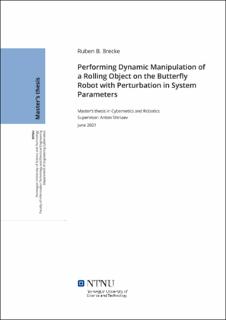| dc.contributor.advisor | Shiriaev, Anton | |
| dc.contributor.author | Brecke, Ruben B. | |
| dc.date.accessioned | 2022-01-03T18:19:49Z | |
| dc.date.available | 2022-01-03T18:19:49Z | |
| dc.date.issued | 2021 | |
| dc.identifier | no.ntnu:inspera:76427839:45143445 | |
| dc.identifier.uri | https://hdl.handle.net/11250/2835881 | |
| dc.description.abstract | En av de vanskeligste aspektene ved ˚a reprodusere menneskelig atferd i robotikk er ˚a utføre
ikke-prehensile (ikke-gripende) objektmanipulering. Dersom roboter skal kunne integreres i
en menneskeskapt verden, m˚a de være i stand til ˚a utføre slike komplekse aktiviteter.
Denne oppgaven tar sikte p˚a ˚a introdusere en ny stabiliserende kontroller til Sommerfugl
roboten gitt at den transverse lineariserte dynamikken er funnet. Systemet best˚aende av en
˚atteformet ramme med en ball som rullet p˚a toppen ble foresl˚att som et standardeksempel
for utvikling av nye teknikker innen ikke-prehensil manipulasjon. Mens tidligere stabiliseringsmetoder er avhengig av en lineær nominell kontroller basert p˚a stabiliserende løsningen
av den periodiske Ricatti differensialligningen (PRDE), vil denne oppgaven introdusere en
”sliding mode control” for ˚a h˚andtere uunng˚aelige forstyrrelser i systemet.
Arbeidet presentert i denne oppgaven bruker en ”virtual holonomic constraint” tilnærming.
Her brukes en skalar-variabel kjent som en bevegelsesgenerator i et geometrisk forhold kjent
som en virtual holonomic constraint for ˚a redusere systemets kompleksitet ved ˚a holde den
geometriske relasjonen uforanderlig gjennom en feedback kontroller. Den nominelle banen
for det ulineære systemet kan deretter avledes ut fra dynamikken til bevegelsesgeneratoren.
Stabiliseringsmetoden bruker den velkjente ekvivalensen mellom et uineært systems lokale,
stabile oppførsel og dets lineariserte systems lokale, stabile oppførsel. Et sett med transverse
koordinater hvis opprinnelse tilsvarer den nominelle banen, kan deretter lineariseres og stabiliseres ved hjelp av en feedback regulator slik at det resulterende ulineære systemet ogs˚a
blir stabilisert.
P˚a grunnlag av den transverse lineariseringen vil det utformes to alternative sliding mode
kontrollere. Den første metoden er enklere og er basert p˚a Lyapunov-teori, der det vil bli
etablert kontrollov som muliggjør en endelig tidskonvergens mot en s˚akalt glidende overflate
(som samsvarer med den nominelle oppførselen). For den andre teknikken vil det opprettes
et reelt ”subspace” av det lineariserte systemet før dens ”annihilator”, hvis samdimensjoner
tilsvarer antall kontrollinnganger, brukes i en svitchfunksjon for kontrolleren. Fordi begge
metodene bruker PRDEs stabiliserende løsning, vil ”semi-definite” programmering brukes
til ˚a finne en tilnærming. Det ble p˚avist at den første metoden raskt konvergerte mot den
nominelle banen for nominelle systemparametere ved numeriske simuleringer, mens for de
forstyrrede parametrene viste en betydelig stasjonær feil, men likevel konvergerte mot banen.
Den andre metoden resulterte ikke i noen vellykket stabilisering, som var forventet gitt at det
ikke ble funnet et subspace som oppfylte de nødvendige betingelsene | |
| dc.description.abstract | One of the most challenging aspects of reproducing human behavior in robotics is performing
non-prehensile (non-gripping) object manipulation. Robots must be able to move and perform
complex activities if they are to be integrated into a human-built world.
This paper aims to introduce a new stabilizing controller to the Butterfly Robot, given that
the transverse linearized dynamics have been found. The system consisting of a figure eightshaped frame with a ball rolling on top was proposed as a benchmark example for developing
new techniques within the field of non-prehensile manipulation. While previous stabilizing
methods rely on a linear nominal feedback controller based on the stabilizing solution of
the periodic Ricatti differential equation (PRDE), this paper will introduce a sliding mode
controller to deal with unavoidable perturbations of the system.
The work presented in this paper uses the virtual holonomic constraint approach. Here, a
scalar variable known as a motion generator is utilized in a geometric relation known as
a virtual holonomic constraint to reduce the system’s complexity by keeping the geometric
relation invariant through a feedback controller. The nominal trajectory for the nonlinear
system can then be derived based on the dynamics of the motion generator. The stabilization
method makes use of the well-known equivalence between a nonlinear system’s local, stable
behavior and its linearized system’s local, stable behavior. A set of transverse coordinates
whose origin corresponds to the nominal trajectory can then be linearized and stabilized using
a feedback controller such that its resulting nonlinear system will be stabilized as well.
Based on the transverse linearization, two alternative sliding mode controller architectures will
be designed. The first method is simpler and is based on Lyapunov theory. A control law will
be established that enables finite-time convergence towards a so-called sliding surface (that
matches the nominal behavior). For the second technique, a real invariant subspace of the
linearization will be created before its annihilator, whose co-dimensions equals the number of
control input, is used in a switching function for the controller. Because both methods use the
PRDE’s stabilizing solution, semi-definite programming will be used to find an approximation.
The first method was proven to swiftly converge towards the nominal trajectory for nominal
system parameters by numerical simulations. In contrast, the perturbed parameters showed a
considerable stationary error but still converged towards the trajectory. The second method
did not result in any successful stabilization, which was expected given that the found subspace
failed to satisfy the required conditions, motivating for further work. | |
| dc.language | eng | |
| dc.publisher | NTNU | |
| dc.title | Performing Dynamic Manipulation of a Rolling Object on the Butterfly Robot with Perturbation in System Parameters | |
| dc.type | Master thesis | |
